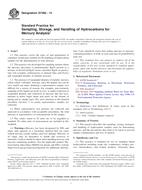Wir benötigen Ihre Einwilligung zur Verwendung der einzelnen Daten, damit Sie unter anderem Informationen zu Ihren Interessen einsehen können. Klicken Sie auf "OK", um Ihre Zustimmung zu erteilen.
ASTM D7482-14
Standard Practice for Sampling, Storage, and Handling of Hydrocarbons for Mercury Analysis
Automatische name übersetzung:
Standard Praxis für Probenahme, Lagerung und Handhabung von Kohlenwasserstoffen für Mercury Analyse
NORM herausgegeben am 1.10.2014
Informationen über die Norm:
Bezeichnung normen: ASTM D7482-14
Anmerkung: UNGÜLTIG
Ausgabedatum normen: 1.10.2014
SKU: NS-38572
Zahl der Seiten: 4
Gewicht ca.: 12 g (0.03 Pfund)
Land: Amerikanische technische Norm
Kategorie: Technische Normen ASTM
Die Annotation des Normtextes ASTM D7482-14 :
Keywords:
handling, mercury, mercury analysis, sampling, storage, ICS Number Code 71.040.40 (Chemical analysis)
Ergänzende Informationen
| Significance and Use | ||||||||
|
5.1 This practice is intended for use in sampling liquid hydrocarbons including crude oils, condensates, refinery process intermediates, and refined products. Generally these samples are expected to contain mercury from the parts per billion (10-9 mass) to parts per million (10 -6 mass) range. 5.2 This practice is not intended for use when sampling aqueous systems where the concentrations of mercury are often in the parts per trillion (10-12 mass) range. These samples are often better addressed by using the rigorously clean techniques from the EPA Method 1669 “clean hands, dirty hands” sampling procedures. 5.3 This practice is not intended for use for liquefied samples, for which special containers may be required for pressurized samples. 5.4 This practice is only suitable for stabilized samples which remain 100 % liquid at ambient conditions. For samples that on depressurization lose some of the light hydrocarbon ends it is important to note that elemental mercury may be lost during sampling. Sampling modules which inject unstabilized liquid hydrocarbons close to process conditions directly to the mercury analyzer can be used to overcome this issue. 5.5 In some refined streams and in tank samples free water may be present. Process streams that are water saturated may condense water as the sample cools from process temperature to ambient temperature. Ionic mercury species are water soluble and these water droplets may contain mercury or adsorb mercury over time. 5.6 The presence of mercury during crude oil production, transport, and refining can be an environmental and industrial hygiene concern. |
||||||||
| 1. Scope | ||||||||
|
1.1 This practice covers the types of and preparation of containers found most suitable for the handling of hydrocarbon samples for the determination of total mercury. 1.2 This practice was developed for sampling streams where the mercury speciation is predominantly Hg(0) present as a mixture of dissolved Hg(0) atoms, adsorbed Hg(0) on particulates (for example, carbonaceous or mineral fines and Fe2O3) and suspended droplets of metallic mercury. 1.3 The presence of suspended droplets of metallic mercury (often called “colloidal” mercury, since the droplet size can be very small) can make obtaining a representative sample very difficult for a variety of reasons (for example, non-isokinetic sampling of the liquid can result in over- or under-collection of suspended droplets and collection of mercury that has accumulated in dense larger drops and pools on the bottom of piping and in sample taps). Pay strict attention to the detailed procedure (Section 7) to ensure representative samples are collected. 1.4 When representative test portions are collected and analyzed in accordance with acceptable procedures, the total mercury is representative of concentrations in the sample. 1.5 The values stated in SI units are to be regarded as standard. No other units of measurement are included in this standard. 1.6 Warning—Mercury has been designated by EPA and many state agencies as a hazardous material that can cause central nervous system, kidney, and liver damage. Mercury, or its vapor, may be hazardous to health and corrosive to materials. Caution should be taken when handling mercury and mercury-containing products. See the applicable product Material Safety Data Sheet (MSDS) for details and EPA’s website (http://www.epa.gov/mercury/faq.htm) for additional information. Users should be aware that selling mercury or mercury-containing products, or both, in your state may be prohibited by state law. 1.7 This standard does not purport to address all of the safety concerns, if any, associated with its use. It is the responsibility of the user of this standard to establish appropriate safety and health practices and determine the applicability of regulatory limitations prior to use. |
||||||||
| 2. Referenced Documents | ||||||||
|
Empfehlungen:
EEviZak – alle Gesetze einschließlich ihrer Evidenz in einer Stelle
Bereitstellung von aktuellen Informationen über legislative Vorschriften in der Sammlung der Gesetze bis zum Jahr 1945.
Aktualisierung 2x pro Monat!
Brauchen Sie mehr Informationen? Sehen Sie sich diese Seite an.




 Cookies
Cookies
